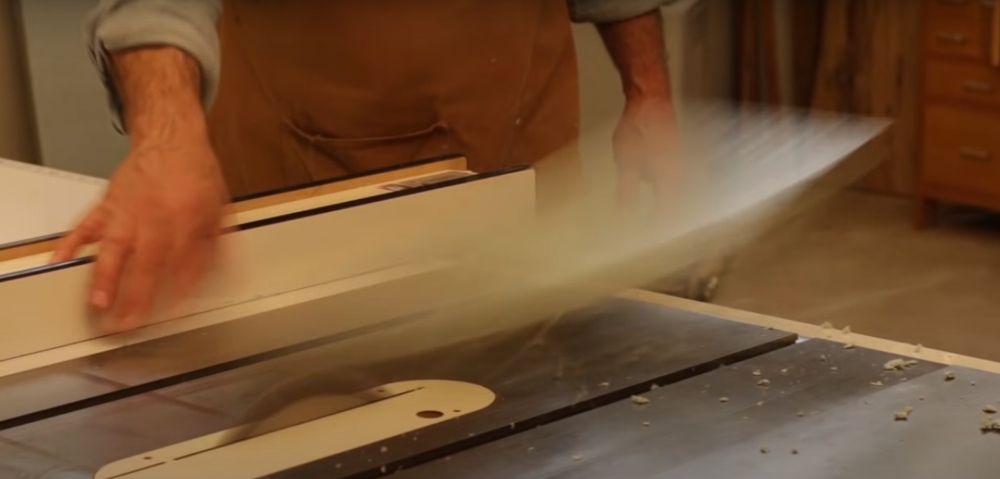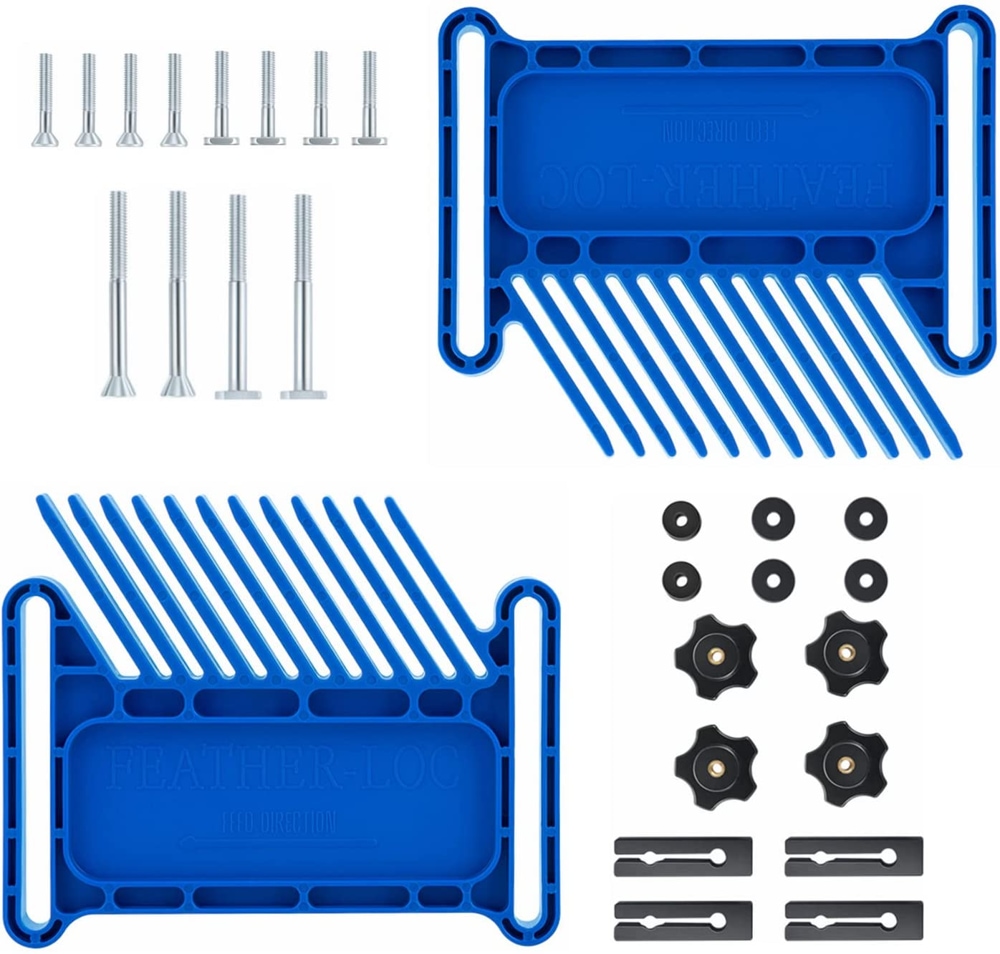Table saws are versatile and powerful tools that you can use to make various cuts such as crosscuts, miter cuts, rip cuts, rabbet cuts, dado cuts, taper cuts, Mortise and Tenon joints, and French cleats. At the same time, it is also one of the most dangerous tools out there, resulting in more than 40,000 injuries annually.
One of the common injuries reported by table saw users is a kickback. Table saw manufacturers also include detailed portions explaining what kickback is and how to prevent it in user manuals so you can read and take necessary precautions to avoid kickback.

In this article, we will discuss what table saw kickback is and how you can avoid it.
What is Table Saw Kickback, and How to prevent it?
Let’s begin our discussion with an explanation of kickback and how it happens!
Kickback happens when a piece of wood is picked up the blade during cutting and is thrown towards you, aimed at your face at a super-fast speed. All the process happens so quickly and abruptly that you don’t get time to react or shield your face with your hands (you are holding the wood piece simultaneously).
The main reason for this is that the workpiece pinches the blade or gets stuck/jammed between the blade and the rip fence.
The image below shows what happens when a piece bounces back due to kickback.

Causes of Kickback
Let’s read in detail all of the circumstances why a kickback can happen
During a Rip Cut: The chances of kickback are the highest when you are making a rip cut. When the board goes halfway through the blade and if the kerf pinches the board, it can lead to stalling of the blade at most, but if your saw is powerful enough, it can propel the blade towards you. This can hurt your face or eyes.
Stuck between Rip Fence and Blade: A spinning blade can throw the piece at you if a workpiece gets stuck in between the rip cut and the blade.
Wrong Feeding to the Blade: If you are not careful while feeding wood pieces to the blade and it comes in contact with the back of the blade, the wood piece can be lifted and thrown towards you at great speed. All of this happens way faster than you can react.
If you are feeding the piece carelessly to the blade, the board can fly out of the way, and the blade can pull your hand. This is bad news if you don’t have a SawStop table saw that stops automatically when your fingers touch the blade.
Misalignment of Rip Fence and Blade: Another potential reason behind kickback is rip fence and blade misalignment. All table saw manufacturers and woodworking experts state that your blade and the fence must be 100% parallel at all times. Make sure you check the alignment periodically to ensure that nothing goes bad due to misalignment.
Preventing Kickback on a Table Saw (Safety Measures to Avoid Kickback)
The problem with the kickback is that it happens so fast, and you can’t tell which way will the wood piece fly. You may be quick enough to duck, but the flying piece can hit other equipment like a window, lightbulb, fellow workers, or anything in your workshop.
Let’s see what ways you can employ to avoid kickback.
Splitter: The splitter is a common table saw safety tool that helps avoid kickback. It is installed at the backside of the blade with the face of the splitter facing the fence, and it is lined up with the teeth of the blade. When the splitter is installed, and you are making a rip cut, and the edge of the board passes over the blade’s backside, the piece can no longer rise and fly off.

Riving Knife: A riving knife is a safety device installed on a table saw, circular saw, or radial arm saw to prevent kickback. It is incorporated into all the modern saws, but older saws don’t have it installed by default.
The good news is that you can install it using a modified blade insert. You can also mount a riving knife on a zero clearance throat plate.
Featherboard: If you don’t have a splitter or a riving knife, a featherboard is the next best thing to control kickback while working on a table saw. A featherboard holds your workpiece against the fence in front of the blade and not behind it. Hence, it is not as quite effective as a splitter or a riving knife, but something is better than nothing.

The above 4 precautions are related to structural components that can help you limit kickback. Let’s check out some usage-related precautions that can also prevent kickback.
Never Make Freehand Cuts: A table saw is a dangerous tool, and it must be given some respect. There is no bravery in making free-hand cuts on a table saw. All of these free-hand cutting techniques shown in TV commercials, movies, and shows are made by professional stunt people and must not be tried at a workshop or in your DIY setup. You must use a rip fence for rip cuts and a miter gauge for miter cuts, and a featherboard or push stick while working with small pieces.
Never Crosscut with a Rip Fence: Rip cutting and crosscutting are different things that must not be mixed. You should never try to make a crosscut using a rip fence.
If you try making crosscuts with a rip fence, the wood piece can get stuck between the blade and the fence and fly off towards you abruptly.
You must not attempt crosscuts without any safety measures. You can make a crosscut sled or buy an aftermarket to help you make crosscuts safely.
Use a Push Stick: As already explained, a push stick comes in handy when cutting small pieces. Using a push stick won’t eliminate kickback, but it can keep your fingers away if the blade pulls your hand in case of a kickback.
Avoid using Damaged Stock: Another critical safety measure that you need to take to ensure proper safety measure is to avoid using damaged, or crooked stock on your table saw. If your wood piece has nails, twists, or knots, it will not allow continuous contact with the rip fence or miter gauge.
Check your Blade: If the blade is dull, broken, or damaged, it can become a reason for kickback. A dull blade can lead to overheating, resulting in misalignment between the blade and the fence, thus breaking contact and causing kickback.
Be Attentive: Pay 100% attention when cutting on a table saw. Make sure that your eyes are glued to the work at hand. If you are not feeling yourself or had drinks last night, it is best to avoid working on tools like a table saw that demand all your attention.
Stand Clear of Kickback Path: If you know that the piece you are working on may lead to kick back, the best way to avoid an injury is to stand clear of the kickback path. The ideal place in this scenario will be on the right side of the blade, with only your hands guiding the piece using a push stick.
Wear Safety Gear: Table saw manufacturers recommend wearing safety glasses, ear protection, and protective footwear. You can wear a faceguard or a safety cap when you think there is a risk of kickback.
Final Words
So now that you know what is a table saw kickback and how you can avoid it, working with the tool becomes safer. We recommend that you follow maximum safety measures and keep all the safety components installed while working on a table saw.
